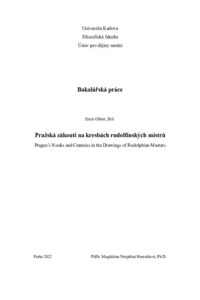Pražská zákoutí na kresbách rudolfínských mistrů
Prague's Nooks and Crannies in the Drawings of Rudolphian Masters
bachelor thesis (DEFENDED)

View/
Permanent link
http://hdl.handle.net/20.500.11956/174990Identifiers
Study Information System: 222965
Collections
- Kvalifikační práce [24015]
Author
Advisor
Referee
Muchka, Ivan
Faculty / Institute
Faculty of Arts
Discipline
History of Art
Department
Institute of Art History
Date of defense
21. 6. 2022
Publisher
Univerzita Karlova, Filozofická fakultaLanguage
Czech
Grade
Excellent
Keywords (Czech)
kresba|veduta|topografie|Rudolf II.|Praha|Pieter II. Stevens|Paulus van Vianen|Roelandt SaveryKeywords (English)
drawing|veduta|topography|Rudolph II|Prague|Pieter II Stevens|Paulus van Vianen|Roelandt SaveryOkolo roku 1600 se Pieter II. Stevens, Paulus van Vianen a Roelandt Savery usadili v Praze, kde během svého působení vytvořili mimořádný soubor vedut. Od starších vyobrazení téže lokality se rudolfínské veduty liší tím, že obsahují převážně intimní městské výseky. Právě tato díla, stejně jako další pražské pohledy jiných rudolfínských umělců, jsou hlavním předmětem bakalářské práce. Zprvu pojednávám umělecký kontext, který je předpokladem pro jejich správné uchopení. Posléze projevuji snahu o jejich dosud nejucelenější shromáždění a podrobuji je topografickému rozboru. Toto vše mi nakonec umožní vyhodnotit míru výjimečnosti krajinářského dění na rudolfínském dvoře, diferencovat přístup každého z umělců a určit, na kolik jsou pražské pohledy autentické. KLÍČOVÁ SLOVA kresba, veduta, topografie, Rudolf II., Praha, Pieter II. Stevens, Paulus van Vianen, Roelandt Savery
Around 1600, Pieter II. Stevens, Paulus van Vianen and Roelandt Savery created an extraordinary set of vedute during their stay in Prague. The Rudolphian vedute differ from earlier depictions of the same locality in that they contain mostly intimate city scenes. These works, as well as other Prague views by other Rudolphian artists, are the main subject of the bachelor thesis. I first discuss the artistic context that is a prerequisite for their proper understanding. Then I make an effort to assemble them in the most complete way to date and provide a topographical analysis of them. All this will ultimately enable me to evaluate the degree of uniqueness of the landscape art at the Rudolphian court, to differentiate the approach of each artist and to determine to what extent the Prague views are authentic. KEYWORDS drawing, veduta, topography, Rudolph II, Prague, Pieter II Stevens, Paulus van Vianen, Roelandt Savery
